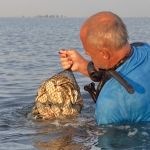Great South Bay Oyster Project
Photo Gallery
Recent Progress
Volunteer
Habitat Restoration

Habitat Restoration
We advocate for healing the creeks that feed our bay, for bay-friendly yards, for helping to return a shellfishing industry to the Great South Bay, and for the deployment of modern wastewater treatment technologies to address the problems caused by 500,000 cesspools and septic tanks, as well as the 197 large scale septic systems in malls, apartment complexes and locally.
Volunteer
Lend a hand! Join our Oyster Project Team and help revive The Great South Bay.
Partnering With Oyster Growers
Of course, nothing happens without cleaner water. That is why getting rid of our cesspools and septic tanks, healing our creeks, tackling runoff, and practicing natural lawn care is so important.
Please contact us with any suggestions you may have. You can also donate our efforts. We want to apply the latest techniques in aquaculture to revitalize our bay, our economy and our local culture.
We advocate for healing the creeks that feed our bay, for bay-friendly yards, for helping to return a shell fishing industry to the Great South Bay, and for the deployment of modern wastewater treatment technologies to address the problems caused by 500,000 cesspools and septic tanks, as well as the 197 large scale septic systems in malls, apartment complexes and locally.
Where You Can Get Fresh, Long Island Blue Point Oysters
- Neguntatogue Oysters (Lindenhurst) – call or text Keith & Nicole at 631-275-8046
- Blue Island Oysters (Sayville)- Call Chris at (631) 563-1330 for availability
- Maris Stella Oysters (Captree) – call or text Sixto at 516-939-5545
- Little A’s (Bay Shore) – call or text Michael at 917-526-1900
- Red Tiger (West Islip) – call or text Lou at 646-228-6273
The Making Of An Oyster Sanctuary
Site Evaluation
Establishing the Sanctuary
Enhancing and Measuring for Success
Recent Progress On Habitat Restoration
When It Comes To Long Island’s Ground Water Pollution Problem, The Facts Are Now Speaking For Themselves
Ever since the release of The Comprehensive Water Resources Management Plan, January 23, 2014, County Executive Steve Bellone has been on a mission to focus attention on the need to address our septic tank and water quality issues. He kicked off matters with a 9500 person conference call on water quality in. He has since then called for funding and for extending sewer districts. Most recently, Suffolk County won an IBM Smarter Cities Award, which will be used to study how best to address the septic tank issue in the county. Bellone worked with Senator Gillibrand to advocate for this. We are thankful to both for working on behalf of Long Island.
Suing The Suffolk County Legislature For Diverting $33 Million in Water Protection Funds
It is only legal and proper that these funds be returned so that Suffolk County, including Steven Bellone’s office, can focus on the enormous task of dealing with Long Island’s water quality issues. With 360,000 septic tanks leeching nitrogenous waste into our ground water, billions will need to be spent on sewering and on modernizing a 19th Century infrastructure. As it stands, our drinking water is threatened, and the polluted ground water is systematically killing all our bays, ponds, and rivers by triggering massive algal blooms. The County cannot ask the public for more money — a lot more money – on one hand while on the other taking that money out to paper over budget shortfalls. It marks a violation of public trust.
A Cleaner Bay, A Cleaner Ocean: Come to the Rally Tues, Feb 11th at 11AM in Mineola. The New Bay Park Sewage Treatment Plant Must Have An Ocean Outfall Pipe
Environmental scientists have been studying for years how The Bay Park Sewage Treatment Plant, originally constructed in 1949, and expanded in the ’70’s and ’80s as Nassau County’s population exploded, has been affecting water quality in the Western Bays. It was found that 85% of the nitrogenous waste in those waters was coming from the effluent from the Bay Park plant. This was destroying marsh, shellfish and fish habitats.
Draft Clean Water Act rules were leaked by House Science, Space and Technology Chairman
Here's a copy of an email from ECOLOG-L regarding draft rule changes in the Clean Water Act. Follow the link at the end for more information. "Last week the draft Clean Water Act rules were leaked by House Science, Space and Technology Chairman Lamar Smith (R-Texas)....
Cuomo Expands Sandy Buyouts to 600 Homes on Long Island
"The state has sent out several hundred letters to homeowners in six clusters, most of them directly along the waterfront on the island’s South Shore. The communities targeted include parts of Lindenhurst, Oakdale, Sayville and Bayport, Patchogue and Mastic Beach, as...
The Atlantic Magazine: On Long Island Coast, An Unexpected Gift From Hurricane Sandy
While Will James depicts the issue of the breach / New Inlet as an ongoing conflict, with a decision in the balance, with the environmentalists pitted against the home owners, a year on post Sandy I’d have to say that the debate over the breach is pretty much over. The public has spoken. Emails, phone calls, public meetings. Many meetings with politicians and policy makers, dozens of environmental organizations working together in support of science and the case for leaving the breach alone. We stand with our flooded neighbors, and want to see them get the help they need quickly, with the money spent wisely and the work done well. At this point, the vast majority understand that spending $20 million to plug the breach would provide absolutely no protection from the next big storm.
The article’s main proponent for closing the breach is Aram Terchunian, who is described in the article as “Long Island coastal geologist who has worked as a consultant on other breach-closure projects.” He is also Founder and CEO of First Coastal, a firm that has made a lot of money on Long Island over the years pushing sand around. He refers to the breach as “a giant hole” must be plugged. To quote Upton Sinclair, “It is difficult to get a man to understand something, when his salary depends upon his not understanding it!” Sandy knocked Fire Island 75 feet north. It took with it 52% of Fire Island’s sand. The water’s coming, and spending $20 million so that a contractor fills it in (at great environmental damage to what is now by far the healthiest part of the The Great South Bay) is pure folly, and most people — scientists and the general public — now know that. He says “its not rocket science” to conclude filling the breach would mitigate flooding, but as he is the lone voice making the argument to close it, arrayed against a number of marine scientists with years of data at their disposal, one must ask him what kind of science he is practicing and where his data is.



















